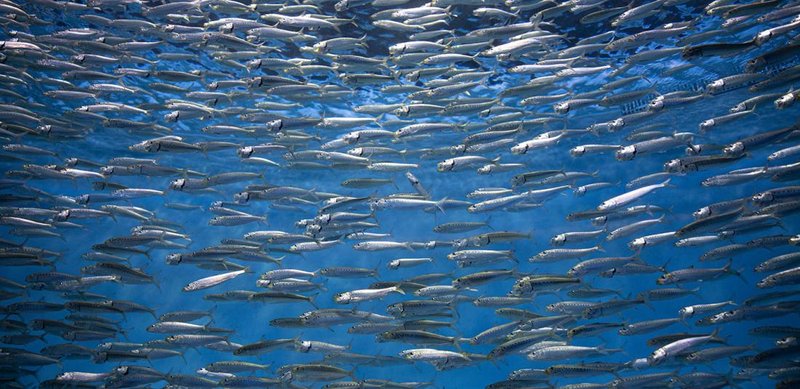
Sardines are a food source for numerous marine animals and play a significant role in nutrient cycling. They may not be the flashiest fish out there, but without them, many marine species would struggle to survive. You might wonder, how can one small fish have such a big impact? Let’s dive into the world of sardines and explore their importance in the ocean’s food web.
Sardines: The Basics
Sardines are small, schooling fish that belong to the Clupeidae family, which includes herring and anchovies. They typically measure around 6 to 12 inches long, depending on the species. Found in oceans worldwide, they usually prefer the nutrient-rich waters close to the coast. These fish are particularly known for their shiny, silver scales, and when they swim together in a school, they can create stunning displays that are mesmerizing to watch.
One of the fascinating aspects of sardines is their ability to thrive in diverse ocean environments. Whether it’s the chilly waters of the Pacific Northwest or the warmer Mediterranean, sardines adapt easily. This adaptability is crucial for their survival, as they need to find environments rich in plankton—their main food source. So, when you think of sardines, picture a small but mighty fish that cleverly navigates its way through the vast ocean.
The Food Chain: Sardines as A Keystone Species
In the marine food chain, sardines play a *keystone role*. This term means that although they may be small in size, they have a disproportionately large impact on their ecosystem. Sardines are a primary food source for many larger predators, including:
- Seabirds
- Marine mammals, like seals and dolphins
- Larger fish species, such as tuna and sharks
Without sardines, these predators would struggle to find enough food, which could lead to a domino effect throughout the ecosystem. It’s a bit like a chain reaction; if one link weakens, the whole structure could collapse.
So, when sardine populations fluctuate, it can have serious consequences for marine life. For instance, an increase in sardine numbers can lead to a boom in predator populations, while a decline may leave those same predators searching for alternative food sources. This delicate balance is crucial for maintaining healthy marine ecosystems.
The Nutrient Cycling Champion
Another key aspect of sardines’ role in marine ecosystems is their contribution to nutrient cycling. When sardines feed on plankton, they help transfer essential nutrients from the water to higher trophic levels, which include larger fish and marine mammals.
Here’s how it works: as sardines consume nutrients found in plankton, they, in turn, become a source of nourishment for those higher up in the food web. When these larger animals consume sardines, they gain energy and nutrients that are vital for their growth and reproduction.
Moreover, when sardines die, their bodies decompose, releasing nutrients back into the water. This process enriches the surrounding environment, promoting the growth of more plankton—creating a *full circle* of life.
Sardines and Human Impact
The relationship between sardines and humans is a complex one. On one hand, sardines are an important source of protein for millions of people globally. They are often found in cans, sushi, and various dishes, providing essential nutrients like omega-3 fatty acids, which are vital for human health.
On the other hand, overfishing poses a significant threat to sardine populations. When sardine stocks decline due to excessive fishing, it can disrupt the entire marine ecosystem. For instance, a sharp decrease in sardine numbers can lead to a rise in phytoplankton populations, which can trigger harmful algal blooms that deplete oxygen in the water.
It’s crucial for us to find a balance. Sustainable fishing practices can help ensure that sardine populations remain healthy, allowing them to fulfill their role in the ecosystem while continuing to provide for us.
The Importance of Habitat
Sardines thrive in specific habitats, which play a vital role in their lifecycle. They typically prefer coastal areas where upwelling occurs, bringing nutrient-rich waters to the surface. This environment is crucial for the growth of phytoplankton, the primary food source for sardines.
Healthy coastal ecosystems, such as estuaries and mangroves, provide shelter and breeding grounds for sardines. These habitats not only support sardines but also help maintain the entire marine food web. So, when we talk about conserving marine environments, it’s not just about protecting one fish; it’s about safeguarding a whole community of life.
Moreover, pollution and habitat degradation can threaten these critical environments. When coastal ecosystems are damaged, sardine populations can decline, leading to ripple effects throughout marine communities. Protecting these habitats is essential for ensuring that sardines continue to play their vital role in the ocean.
Sardines may be small, but their role in marine ecosystems is anything but insignificant. They’re at the heart of food webs, support nutrient cycling, and contribute to the health of marine environments. The balance they help maintain is crucial for all ocean life, including the larger predators we admire.
As stewards of our planet, it’s our responsibility to protect sardines and their habitats. Whether through sustainable fishing practices or habitat conservation, we can ensure that these little fish continue to thrive in the ocean. So, the next time you see a can of sardines on the shelf or hear about them in a documentary, remember this: behind their unassuming exterior lies a world of importance. Without sardines, the ocean and the creatures that inhabit it would be a very different place.
